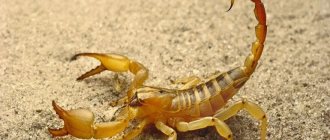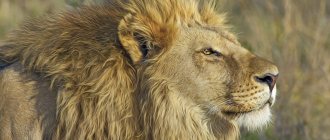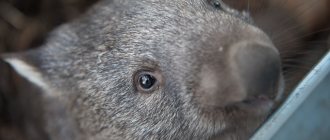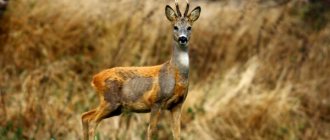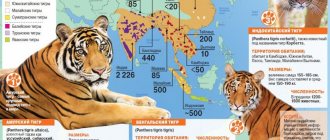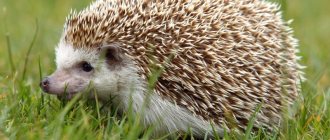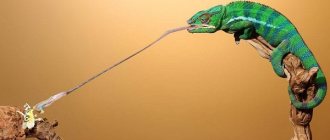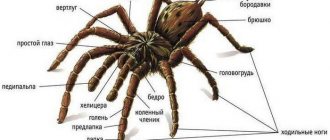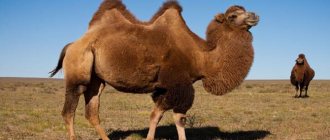Briefly about the scorpion squad
Because of their resemblance to crayfish, scorpions are sometimes called land crayfish. Indeed, the body of a scorpion is covered with chitin. Two large forelimbs end in impressively sized claws. Four pairs of running legs are attached to a wide anterior abdomen, and a long posterior abdomen, popularly called a tail, ends in a round formation with a needle-sharp spine at its end. It is in it that the poisonous gland of the animal is hidden. Scorpions have a pair of large and up to five pairs of small lateral eyes at the front end of the body.
The structure of scorpions. The picture is clickable and can be enlarged
The sizes of scorpions are different - from 2-3 cm to 15-25 cm. Their coloring is also different. Often there are species of scorpions that have a yellow or yellow-green color. the yellow-green scorpion lives in Southern Europe . In small animals the body sometimes appears translucent, in others it has thicker tones, even with a brownish tint. For example, the motley scorpion , as well as the black or thick-tailed one . Large tropical scorpions are dangerous to humans.
Black or thick-tailed scorpion (Androctonus). He has poor eyesight, however, this does not prevent him from hunting and feeding on large insects and small vertebrates.
The famous Russian scientist Academician Evgeniy Nikanorovich Pavlovsky, speaking about scorpions, thoughtfully said: “I wonder why over the millennia, when geographical conditions changed, entire classes and orders of animals died out, and scorpions not only remained similar to their distant ancestors, but also retained the same way of life same. It still remains a mystery."
Indeed, many land creatures have undergone significant metamorphoses, while scorpions have retained their original appearance. Why? There is only one answer: apparently, nature created them so perfect, endowing them with a sufficient margin of safety, that changing environmental conditions did not introduce anything into their external and internal structure. By the way, in the same regard, we can recall such animals as crocodiles and turtles, the appearance of which has also remained virtually unchanged compared to their ancient ancestors.
The most recognized is the theory of the origin of scorpions, created by the biologist-parasitologist Academician E. N. Pavlovsky and supplemented by A. A. Byalynitsky-Birulya. According to these scientists, during the Silurian period of the Earth's development, the scorpion belonged to the animals living in coastal sea waters. He became the ancestor of the terrestrial representatives of the order of scorpions. The first land scorpions appeared already in the Devonian period - more than 300 million years ago. All modern families of scorpions formed 70 - 100 million years ago.
The fact that scorpions have not changed under the influence of the environment for thousands of years is evidenced by the imprints of the bodies of ancient scorpions on stones. They are not much different from modern representatives. This ancient order of arthropods, oddly enough, has been little studied.
Currently, 77 genera and up to 700 species are known from the scorpion families, and in Russia and neighboring countries, 7 genera and a total of 12 species of these arachnid animals are distinguished from 2 families. Famous Caucasian species of scorpions are yellow, thick-tailed (or black), kolkhaz, and Abkhazian. There are 5 species of scorpions in the Caucasus, of which in Azerbaijan there are 3 species belonging to the same genus. There are over 80 species of scorpions in India.
The scorpion of the species Leiurus quinquestriatus is the most poisonous representative of the order. The color of the animal may vary depending on the habitat
Scorpions can be found at the foot of the mountains and high in the mountains - at an altitude of up to 2 thousand m above sea level, as well as in hollows, gorges, deserts, often rocky, where there are more insects and other food items. They can often be found in the most unusual places for them, especially in tropical regions.
In less warm areas, with the onset of cold weather, scorpions go into hibernation. Scorpions hibernate in deep, sometimes up to 4 m, cracks in rocks, under stones, and sometimes in human housing.
Scorpions are distributed mainly in areas with hot and warm climates. Most cases of human poisoning from the poison of these animals have been recorded in South and Central America, Mexico, North and South Africa, and the Middle East. In Brazil, for example, from 0.8 to 1.4% of injured adults die from scorpion bites, among schoolchildren - 3 - 5% of those bitten, and among young children, mortality from bites reaches 15 - 20%. These are quite high numbers.
Currently, the venom of scorpions, like spiders, is used in biochemistry, molecular biology, neurophysiology and other branches of science.
General structure
Scorpions have a body divided into a cephalothorax and abdomen. The abdomen is articulated and consists of two sections: a wide anterior one and a long narrow posterior one, which is often incorrectly called the “tail.” The last part of the abdomen is deflated and has a sharp, nail-like spike - a sting; inside this part there are two venom glands, which open into two holes at the end of the sting. The scorpion kills prey with an injection of its sting, while bending its “tail” over its back towards the victim, which it holds with its pedipalps.
Body
The body of scorpions consists of small cephalothorax (cephalothorax), which arose from the fusion of several segments and a long abdomen (abdomen), in which two sections are distinguished: the anterior section, wider and 7-segmented (praeabdomen), is closely adjacent to the cephalothorax and forms one with it the whole (the body of a scorpion, in ordinary language), and the posterior section, narrow, 5-jointed (postabdomen), sharply demarcated from the preabdomen and having something like a tail (P). Adjacent to the last segment of the post-abdomen is another, pear-shaped segment, which ends with a needle closed upward, at the top of which there are two openings of the poisonous glands (st). This segment does not correspond to the segment, since it is located behind the anus, in the caudal process (telson of the cancer).
The entire body of scorpions is covered with a chitinous shell, which is a product of the secretion of the underlying hypodermic layer. There is a cephalothorax shield covering the cephalothorax from the dorsal side, then in the pre-abdomen area, according to the number of segments, 7 dorsal and abdominal shields, connected to each other by a soft membrane, and, finally, in the post-abdomen area, 5 closed dense chitinous rings connected by thin skin.
Limbs
On the ventral side of the body, six pairs of limbs are attached to the cephalothorax, of which the 2 anterior pairs play the role of jaw organs, while the other four pairs serve for walking. The first pair of limbs is located above the mouth opening and in its position corresponds to the tentacles of other arthropods, and in its physiological function - to the mandibles, and therefore is called tentacle mandibles or chelicera; they are a type of small 3-segmented horizontal claws and are used for grinding food. The second pair of 6-jointed limbs, with their main segments, plays the role of jaws and in appearance resembles legs, ending with large claws, with the help of which scorpions grab the victim. In other arachnids they are a type of tentacle - and therefore called jawed tentacles.
Intestines
The intestine consists of three sections: the foregut, midgut and hindgut; the oral opening is located on the ventral side and leads into the muscular pharynx (pharynx), which acts as a pump, passes into the esophagus (oesophagus) at the beginning very narrow, then widens and receives the excretory ducts of two large salivary glands. The esophagus passes into the midgut, in which a large multi-lobed liver opens in the preabdomen area with the help of 5 pairs of excretory ducts and fills all the spaces between other organs. The midgut gradually passes into a short hindgut, which opens with the help of a powder outward in the last segment on the abdominal side. The nervous system consists of the suprapharyngeal ganglion, the peripharyngeal commissure and the ventral nerve cord. Nerves to the eyes and tentacles extend from the suprapharyngeal bilobed ganglion. In the abdominal nerve chain, there is one large subpharyngeal ganglion, which is the result of the fusion of all the thoracic ganglia, and seven abdominal, that is, three pre-abdominal and 4 post-abdominal (located in the tail) ganglia.
Sense organs
The eyes are the best developed and studied. In S., on the upper side of the cephalothorax there are 3-6 pairs of eyes, of which one pair, differing in size and more complex structure, is located in the middle of the cephalothorax and is called the median eyes, while the others are located in lateral groups near the anterior edge and are called the lateral eyes. The latter consist only of a cuticular lens and one layer of cells - large terminal nerve cells with a lateral column and a special ball that strongly refracts light, and smaller, indifferent or supporting cells. The middle eyes have one large cuticular lens, and under it a separate non-pigmented layer of the vitreous body, delimited by a membrane from the adjacent layer of terminal nerve cells, or retina; in retino, every five cells are connected to each other into one group - the so-called retinula, isolated from neighboring retinula by a layer of pigment; Each retinal cell secretes on its inner surface a glassy column, or rhabdomere, which connects with the neighboring 4 rhabdomeres into one rod, or rhabdom.
These S. eyes represent a transition from a simple eye to a faceted arthropod. S. also have very unique sense organs - the so-called. comb-shaped organs (pectines), which have the appearance of a plate bordered on one side by denticles and generally resembling a comb; they are located on the abdominal side of the second abdominal segment, near the genital openings they are supplied with an abundance of nerve branches. They serve, in all likelihood, as tactile organs, and their close position to the genital organs suggests that they are arousal organs during copulation.
Circulatory organs
The circulatory organs do not represent a closed system, being in communication with or lacunae areas of the body cavity.
The heart is placed on the dorsal side in the pre-abdomen and lies between the lobes of the liver, encased in a special membrane that separates the pericardial cavity filled with blood. It looks like a long tube divided into eight chambers. Each chamber is equipped with one pair of slot-like openings (ostes) with valves; at both ends, the heart continues into two main arteries: the anterior one, which goes to the head (aorta cephalica), and the posterior one, which goes to the post-abdomen (arteria posterior); in addition, another pair of lateral arteries departs from each chamber. The two areas of the main artery form a vascular ring around the esophagus, from which the large artery extends back, lying above the nerve cord. When the heart contracts, blood enters the anterior and posterior aortas and from them into small vessels and is finally collected in two longitudinal abdominal sinuses, then sent to the pulmonary leaves, oxidized there and, with the help of special channels, returns to the pericardial cavity (pericardium), and from there through the cracks during diastole back into the heart.
The respiratory organs are contained in the pre-abdomen and are represented by the lungs, which look like 8 large air sacs, protrude into the body cavity and open outward with the help of narrow oblique slits of holes, so-called. stigmata, or dikhalets. The latter are located in pairs on the ventral side of the preabdomen, on the sides in 3-6 segments.
Respiratory system
The pulmonary sacs of scorpions are modified gill-bearing limbs, appearing in place of the rudiments of the abdominal limbs existing in the embryonic stage of development. The excretory organs are still little studied and consist of two long and thin vessels (Malpighian vessels), opening into the posterior part of the hindgut. Lymphatic glands were recently found by Kovalevsky in scorpions and appear as one pair of sac-like or several irregularly shaped glands adjacent to the nervous system and containing amoeboid (phagocytic) cells that greedily eat and are introduced into the body cavity of S. various foreign substances (ink, carmine , iron, anthrax bacteria, etc.)
Order Solpuga, or Phalanx (Solifugae)
Phalanxes live in steppes and deserts. The body length of Galeodes araneoides, found in the south of Russia, reaches 5 cm (Fig. 3). The cephalothorax is not fused, consists of an anterior section, including an acron and four segments, and three free segments. There are four pairs of walking legs. The massive abdomen consists of ten segments. The chelicerae are large, claw-shaped. Each claw opens and closes in a vertical plane. The long pedipalps are similar to walking legs and are involved in locomotion. Respiratory organs - trachea. Salpugs are nocturnal predators, feeding mainly on insects, which they actively hunt. There are no poisonous glands. The body and limbs of salpugs are covered with long hairs. The eggs are laid in a burrow, and the female takes care of the offspring.
► Description of other classes and orders of the Arthropod type:
- Class Trilobita
- Class Crustaceans
- Class Arachnida Order Spiders (Aranei)
- Scorpion order (Scorpiones), Solifugae order (Solifugae)
- Order Parasitiformes, order Acariformes
► The section Bilaterally symmetrical (Bilateria) subkingdom Multicellular also includes:
- Type Flatworms
- Type Roundworms
- Type Annelids
- Type Shellfish
► Go to the table of contents of the book “Zoology of Invertebrates. Theory. Tasks. Answers"
Reproduction
Scorpios are viviparous. The female gives birth to several dozen developed individuals, which sit on the mother’s back for a certain time. Scorpions reach sexual maturity at the age of 4 - 5 years.
Genitals
All scorpions are dioecious, and in appearance they differ only in size. The male genital organs consist of one pair of testicles, each of which is formed from two longitudinal thin tubes lying in the pre-abdomen between the lobes of the liver and interconnected by transverse canals. Each pair of tubes at the anterior end of the body passes into the excretory canal (vas deferens), connected to each other in the midline and opening on the abdominal side of the body in the first abdominal segment outward. One long and one short sac open into the excretory ducts on each side, of which the first is the seminal vesicle (vesicula seminalis). The female genital organs are located in the same place as the male ones, and consist of two longitudinal tubes, which pass in an arched manner at their posterior end into the third, middle one, and, in addition, are connected to it by four transverse canals. This system of tubes collectively forms the ovaries (ovarii). At the anterior end, oviducts (oviducti) extend from both lateral tubes, expanded fusiformly, which form seed receptacles (receptacula seminis); the two oviducts are connected into one odd excretory duct, which opens outward on the ventral side of the body in the first abdominal segment. The female and male genital openings are covered by two plates - the genital operculum is the modified abdominal limbs and corresponds (in position) to the genital or gill plate of the horseshoe crab Xiphosura.
Scorpions are viviparous animals, undergoing direct development without metamorphosis.
The female carries the young and shows great care for her offspring. The eggs are meroblastic, telolecithal and undergo partial cleavage. The cells, coming to the surface, form a single-layer germinal circle, which grows and gives rise to the ectoderm, and from the cells that descend down (into the nutrient yolk) the lower layer is formed - a common rudiment for the endoderm and mesoderm. Then, a ring fold is formed on the surface of the embryonic circle, growing from the periphery to the center and merging with its inner edges above the germinal band, forming embryonic membranes, and its outer layer forms the so-called serous membrane (serosa), and the inner one - the amnion. The rudimentary strip, covered by the amnion, grows in length and is divided into segments, indicated by transverse grooves not only on the ectoderm, but also in the mesoderm, the latter breaking up into paired sections. The mesoderm segments are then split, when they arise inside their cavity, into a dermal-muscular and intestinal-muscular plate.
Soon, the rudiments of the limbs appear on the segments of the body: on the first segment, on the sides and behind the mouth, the rudiments of the tentacle-mandibles are laid (thus corresponding to the mandibles, and not the tentacles of insects), on the second - jaw tentacles, and on the next four thoracic segments - 4 pairs of walking legs. On the 6 anterior segments of the abdomen, small rudiments of limbs are also formed, of which the first pair turns into genital operculum, the second into comb-like appendages, and the remaining four pairs disappear, and in their place (by invagination) the spiracles of the pulmonary sacs appear later. The nerve ganglia of the first segment, innervating the tentacles, subsequently merge with the head (suprapharyngeal) nerve ganglion; Thus, although in adult S. the tentacular mandibles receive nerves from the suprapharyngeal ganglion, they are not homologous with the tentacles of prototracheals, millipedes and insects, but correspond to the mandibles of Arthropoda.
Scorpion poison apparatus
On the very last segment of the abdomen there is an ampulla - a round formation covered with chitin. Inside the ampoule there are 2 pear-shaped glands, which at the very end of the tail spike-needle end in two small holes. The outlet channel runs from the glands to the tip of the needle. From above and from the inside, each poisonous gland is surrounded by a layer of muscles, during the contraction of which the secretion of the glands is thrown out. Animal venom is very dangerous. The scorpion grabs the victim with its claws, bends the narrow part of the abdomen in an arc forward and plunges the needle into the body of the prey.
Spreading
Scorpions, which belong to several species living in the south of Crimea, on the Black Sea coast of the Caucasus, in Transcaucasia, and Central Asia. All day long, scorpions hide under stones, in earthen burrows, under bark, in cracks in rocks and adobe walls of buildings, between firewood and can enter a home. At night they go hunting. They feed on insects, spiders and the like. The bites of scorpions that live in our area are, as a rule, not fatal to humans, but cause severe pain, swelling of the limbs, fever, drowsiness, etc. Antitoxic antiscorpion serum is used as a specific remedy against bites.
Danger to humans
The insect's venom has neurotoxic properties. It constantly accumulates in the glands, so a bite can cause the most unpleasant consequences.
- Fortunately, there are two types of poison:
- Most scorpions are capable of paralyzing insects, but for a person the bite will pass without any special consequences - swelling, itching at the site of skin damage and moderate pain (as with a bee or wasp sting) may occur.
- The second type of poison affects primarily mammals. In humans, such poison can cause paralysis of the nervous system, which will lead to disturbances in the functioning of the heart and lungs. Vomiting and increased salivation occur. Without the introduction of an antidote, death is possible. This poisonous bite is especially dangerous for young children.
Severe intoxication in humans is caused by the poison of 25 species of scorpions out of 50, which have the ability to paralyze a mammal.
The easiest way to determine the poisonousness of an insect by eye is to visually compare the proportions of its body. Dangerous species have rather small limbs and a powerful abdomen with a large needle. Species that are not dangerous to humans have impressive claws, but have a small sting. A fatal bite can be obtained from Androctonus, native to the Middle East and Africa. This species is also called the “man-killer.” Scorpio has a black body color and reaches a length of 10 centimeters. Several deaths caused by the sting of the Androctonus scorpion are reported each year.
This species is considered the most dangerous to humans in the world. Pharmaceutical companies produce an antidote to relieve intoxication caused by the venom of this scorpion. In total, there are 18 species of Androctonus from the butid family in the world. These include the extremely poisonous Androctonus amoreuxi and Androctonus australis. Androctonus amoreuxi is found in Africa and Asia. The scorpion is colored light yellow and often hides in sand dunes. Sightings with this species were also recorded in Uzbekistan. Androctonus australis is also a native of Africa and Asian regions. The color of the insect is sandy, body length is up to 12 centimeters. In addition to insects, the scorpion feeds on small rodents.
Development
Development in scorpions is direct, without metamorphosis. The period before the first molt lasts from 5 to 25 days, depending on the species. The brood molts for the first time simultaneously in a process that lasts 6 to 8 hours, marking the beginning of the juvenile stage. Juvenile scorpions usually resemble smaller versions of adults, with fully developed pincers and stingers. Their covers are still soft and devoid of pigments, so the babies continue to ride on the back of their mother, who protects them. Over the next two days, the skin becomes harder and more pigmented. Scorpios may temporarily leave their mother and return when they sense potential danger. Once the exoskeleton has completely hardened, young scorpions begin independent life. A scorpion can molt an average of six times before reaching sexual maturity, which may not occur until between 6 and 83 months of age (depending on the species). Some species of scorpions live up to 25 years.
Habitat
Scorpions live in countries with warm or hot climates, and are found in a wide variety of habitats, from humid forests and littoral zones of sea coasts to barren rocky areas and sandy deserts. Some types of scorpions are especially common in human housing. They can crawl along the wall up to the second floor. In housing, scorpions can crawl into removed shoes, into folds of clothing, etc. Even more often, scorpions can crawl into temporary camp housing - tents, huts, etc.
Scorpios prefer areas where temperatures range from 11-40°C. Scorpions can also withstand extreme heat: Leiurus quinquestriatus, Scorpio maurus and Hadrurus arizonensis can live at temperatures of 45-50°C if they are sufficiently hydrated. Desert species such as Pectinibuthus birulai live in a temperature range of 30-50°C. Desert scorpions have several adaptations to conserve water; they get most of their moisture from the food they eat, but some can absorb water from moist soil. Scorpions living outside deserts prefer lower temperatures. Some species hibernate. Species that live in denser vegetation and at more moderate temperatures drink water from plants and puddles.
Economic importance
Scorpions living within Russia do not pose a great danger to humans. Scorpion stings are a serious problem in tropical and subtropical regions of the Americas, North Africa, the Middle East and India. About 1.5 million cases of scorpion stings occur each year, resulting in 2,600 deaths. Mexico is one of the worst-affected countries, with the highest scorpion biodiversity in the world, with about 200,000 stings a year and at least 300 deaths.
Related article Names for arthropods (male)
I
Scorpion venom is a clear, viscous liquid, colorless or slightly greenish. The amount of poison released depends on the type and age of the scorpion. The toxicity of the venom of different types of scorpions for different animals and for humans is different. The venom of scorpions has a certain similarity to the venom of snakes, since it has a neurotoxin: it paralyzes the nervous system, causes blood clotting, affects the walls of capillaries, and agglutinates red blood cells. Fatal poisoning of adults by scorpion venom is noted as very rare - and only when stung by some tropical species. Children are more susceptible to the toxic effects of scorpion venom, so fatal poisoning occurs more often in them than in adults. In mild cases, the symptoms of poisoning go away on their own. In more severe cases, and especially when children are stung by a scorpion, local and general treatment is necessary.
Emperor scorpion (Pandinus imperator)
The scorpion itself never attacks a person; if you step on it, press it with your body or hand, then a blow with a poisonous sting will inevitably follow. This can happen when putting on shoes into which a scorpion has crawled, when picking up stones or dead wood, when lying on the ground, and in other circumstances. Prevention of stings includes such personal actions as checking and shaking shoes and clothing before putting them on, not walking barefoot or wearing sandals, and filling holes and cracks where scorpions might hide. Street lighting reduces scorpion activity. Controlling scorpion numbers may involve using insecticides such as pyrethroids or collecting scorpions by hand using ultraviolet light.
Scorpions are eaten in West Africa, Myanmar and East Asia. Fried scorpions are traditionally eaten in China. The stings, as a rule, are not removed, since direct and prolonged heating negates its harmful effects. In Thailand, scorpions are not eaten as often as other arthropods such as grasshoppers, but they are sometimes fried as street food.
Scorpions are kept as pets. They are relatively easy to maintain, since the main requirements are a reliable container and appropriate temperature and humidity for the chosen species. The substrate should resemble the species' natural habitat. Scorpions of the genera Pandinus and Heterometrus are quite docile to handle. The pet trade has threatened wild populations of some scorpion species, especially Androctonus australis and Pandinus imperator.
The scorpion is a culturally significant animal among many peoples, especially in Islamic art in the Middle East. Scorpions are used in folk medicine in South Asia, especially in antidotes for scorpion stings. One of the earliest cultural manifestations of Scorpio is its inclusion in the 12 signs of the Zodiac by Babylonian astronomers during the Chaldean period. This was then picked up by Western astrology; in astronomy the corresponding constellation is called Scorpius. In Ancient Egypt, the goddess Serket, who patronized the pharaoh, was often depicted as a scorpion. In Greek mythology, Artemis sent a giant scorpion to kill the hunter Orion, who said he would kill all the animals in the world. Orion and Scorpio became constellations; as enemies, they were placed on opposite sides of the world, so when one rises into the sky, the other lands. Scorpions are mentioned in the Bible and Talmud as symbols of danger and malice.
Features of vision of arachnids
The various species groups of this class are well adapted. For many, the primary role is played not by the eyes, but by tactile sensations. They have areas of increased sensitivity on the surface of their body. There are especially many tactile hairs on the jointed paws, which are responsible for movement, and on the pedipalps (legs).
Many arachnids weave trapping webs. By the smallest vibrations of the threads, they learn about the prey they have caught. Visual perception is less important. Species that lead a nomadic lifestyle and hunt without a web have more developed vision. To move through unfamiliar terrain, they must be able to distinguish the surrounding reality.
However, their visual system cannot be compared with the “optics” of developed higher insects. The eyes of a scorpion (photo below) also do not differ in the complexity of their structure or the peculiarities of color rendering. It is believed that representatives of this suborder see even worse than spiders and are able to distinguish their own kind only from a distance of several centimeters.
Reasons for confusion
Why do such misconceptions arise? Let's highlight a few reasons:
- All insects are animals.
- Scorpions are comparable to insects, have a similar external structure and color.
- Many types of insects live near scorpions.
- Similar diet.
- Belonging to the phylum of arthropods.
This is why many find it difficult to answer the question of whether a scorpion is an insect or an animal. At first glance, there are indeed many similarities. But once you dig deeper, you will discover a huge number of differences.
